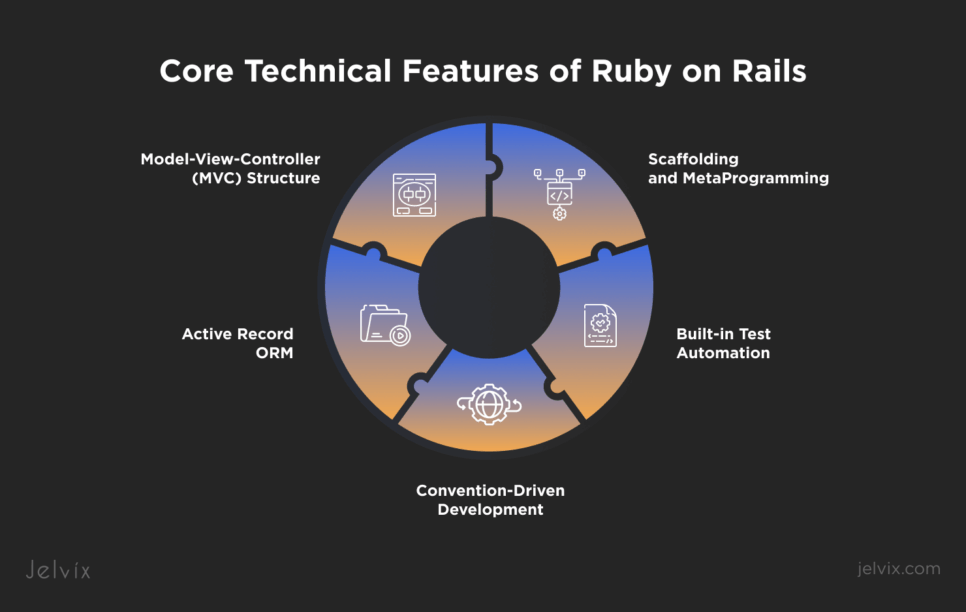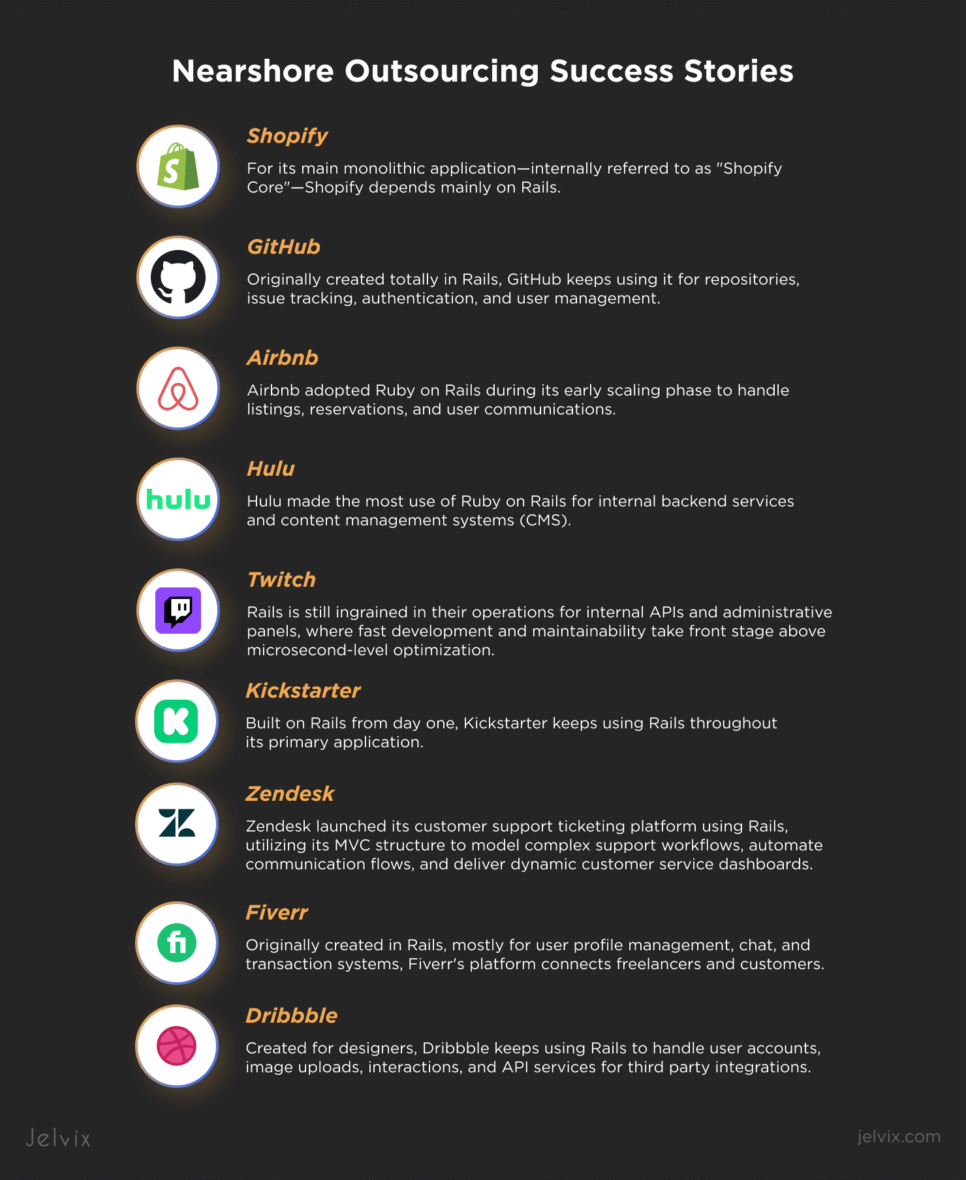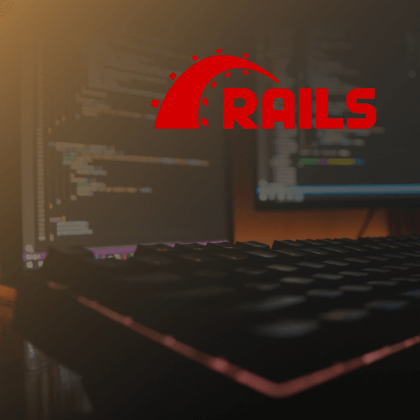Ruby on Rails (RoR) is still notably, albeit specialized, present in the web development landscape. W3Techs estimates that Ruby is used by about 4.1% of all websites whose server-side programming language is known as of 2025, a figure that demonstrates its sustained relevance.
RoR’s consistent adoption points to something more fundamental in an ecosystem progressively split by newer frameworks and microservices: its ability to effectively satisfy core development demands.
More than fast prototyping, modern web development needs scalability, security, and developer ergonomics without compromising project timeframes. Ruby on Rails still fits these needs with its established ecosystem of libraries (gems), structured MVC pattern, and strong convention-over-configuration approach.
Particularly for businesses trying to strike a mix of speed, maintainability, and commercial scalability, RoR provides a tested, flexible basis free from locking teams into strict processes or too high technological overhead.
In this post, we’ll dive deeper into the answer to the fundamental question: “What is Ruby on Rails used for in 2025?” and why its principles still fit today’s demands. You will discover how RoR’s architectural foundation, speed, and large community make it a strategic advantage.
From e-commerce behemoths to SaaS pioneers to media disruptors, we will map out the sectors where Rails thrives and highlight significant businesses that still trust Rails for their basic applications. Let us now dig into it.
What Is Ruby on Rails and Why It Still Matters
Built on the Ruby programming language, Ruby on Rails—often just known as Rails—is a full-stack web application framework. Designed from the outset to prioritize developer happiness and sustainable output, Rails was developed by David Heinemeier Hansson under the MIT License.
While supporting standards like JSON, XML, HTML, CSS, and JavaScript for seamless data flow and front-end integration, closely following the Model-View-Controller (MVC) architecture, it offers a clean structure for handling database interaction, server functionality, and user interfaces.
Fundamentally, Rails supports two significant software engineering ideas: Convention over Configuration (CoC) and Don’t Repeat Yourself (DRY). While CoC lowers decision fatigue by establishing reasonable defaults, DRY minimizes duplicate code and promotes better, more maintainable systems.
These concepts, taken together, help explain why many businesses have continued to choose Ruby on Rails.
Rails first created waves in 2004, but it wasn’t widely embraced until 2005. It accelerated much more when Apple released it along with Mac OS X Leopard in 2007.
Rails has kept changing since then; versions like Rails 5.0 brought features like Action Cable for WebSocket integration, API mode for lightweight services, and Turbolinks 5 for faster page loading, strengthening its relevance in a fast-moving technological scene. Modern Ruby on Rails projects use these tools to address practical scalability, performance, and usability issues.
Rails provides a complete environment, unlike niche models that concentrate just on front-end or back-end development. It covers everything from built-in testing systems to database abstraction using Active Record to robust metaprogramming capabilities.
By working across the whole application stack without having to cobble together a dozen loosely connected technologies, developers using RoR web development services may create more coherent and simplified builds.
Technically, Rails offers several standout features:
- Model-View-Controller (MVC) Structure;
- Active Record ORM;
- Scaffolding and MetaProgramming;
- Built-in Test Automation;
- Convention-Driven Development.
Of course, Rails is not without its trade-offs. Runtime performance may lag behind lighter-weight systems like Node.js or Golang in certain high-throughput scenarios, and the startup boot time can be slow for projects with a heavy load of gem dependencies.
Multithreading limitations in some IO libraries and a tightly coupled Active Record pattern also require thoughtful engineering to scale cleanly under heavy loads.
However, when examining which companies use Ruby on Rails—from startups prototyping new ideas to enterprise software development businesses—a clear pattern emerges: organizations prioritize developer productivity, application robustness, and long-term maintainability.
Key Benefits of Using Ruby on Rails
Selecting Ruby on Rails for web application development is hardly a nostalgic choice; it is a calculated move motivated by real benefits.
First, Rails is still among the fastest frameworks for turning concepts into reality. Its capacity, opinionated structure, and abundance of well-kept libraries let developers concentrate on addressing corporate challenges instead of battling low-level setup.
Teams benefit from rapid iteration cycles—a crucial edge when user feedback or market shifts demand quick pivots.
Beyond performance, Rails offers a community and ecosystem few systems can match. Developers have created an enormous library of open-source gems, automation tools, security fixes, and best-practice guidelines over almost two decades, surrounding Rails with a strong support system.
Such a library protects against architectural errors that younger frameworks often let sneak in unnoticed. It’s not coincidental that many of the most technically disciplined corporations show up at the top of the list of companies using Ruby on Rails.
Eventually, Rails’s “Convention over Configuration” concept is still applicable in 2025. While developers are allowed to personalize as needed, they aren’t forced to create security models, data layers, or routing systems from scratch.
This balance explains why utilizing Ruby on Rails is still a question with a solid answer: it speeds onboarding, enhances code consistency across teams, and reduces friction in product scaling.
Actually, these advantages compound each other. Faster prototyping results in faster releases; better community standards help to reduce development surprises; predictable norms help to cut maintenance costs. Ruby on Rails provides a structure designed for tomorrow’s expansion rather than only today’s deliverables.
Top Industries Leveraging Ruby on Rails in 2025
Ruby on Rails is still a pillar framework across several important sectors where dependability, fast evolution, and scalability are non-negotiable, even if it may no longer rule every aspect of web development.
Rails is still a top choice in e-commerce and online markets because of its capacity to manage scalable payment integrations, fast-moving inventory, and sophisticated user flows. Rails is a natural fit for systems where consumer behavior changes overnight since its convention-driven environment helps teams to adjust fast without creating technological instability.
SaaS platforms and enterprise tools also continue to rely heavily on Rails. Unlike simple web apps, SaaS products often involve layered permissions, real-time analytics, billing automation, and complex onboarding flows. Rails is a good foundation for these demands, given its structured MVC pattern and dynamic ecosystem of authentication and subscription management libraries.
Rails silently drives apps to manage vast amounts of dynamic data in media, streaming, and content services. From customized content feeds to metadata-rich catalogs, these systems call for both consistency and flexibility. Together with its flawless integration with contemporary front-end systems, Rails’ built-in API support lets media companies distribute content across web, mobile, and connected devices without separate backend systems for each.
Ruby on Rails applications regularly satisfy the needs of today’s high-traffic content platforms, where quick data handling and robust APIs are vital.
Leading Companies Using Ruby on Rails
Even though there have been a lot of new frameworks and languages in the last ten years, Ruby on Rails is still used for the core systems of some of the world’s most reliable and popular platforms. The long list of well-known companies that use Ruby on Rails shows that the framework isn’t just staying alive in 2025; it’s actually helping to drive growth around the world.
Shopify
For its main monolithic application—internally referred to as “Shopify Core”—Shopify depends mainly on Rails. Mostly written in Ruby on Rails, this system handles merchant account management, checkout procedures, and crucial workflow, including storefront rendering. Using solutions like Kubernetes and Kafka, Shopify expanded its Rails stack with a modular service architecture, but Rails remains its core.
Few Ruby on Rails development companies have operated Rails at Shopify’s scale, making their optimizations, such as custom caching layers and advanced ActiveRecord usage, notable case studies.
GitHub
Deep Rails integration is another strength of GitHub. Originally created totally in Rails, GitHub keeps using it for repositories, issue tracking, authentication, and user management. GitHub modularized bits of its system over time, adding Go and other technologies, but most of its high-frequency interactions still run on Rails-backed services.
Scaling GitHub’s daily read/write-intensive operations depends critically on Rails’ MVC and background job processing tool support.
Airbnb
Airbnb adopted Ruby on Rails during its early scaling phase to handle listings, reservations, and user communications. The speed of development enabled Airbnb to iterate on user features quickly while standardizing their database schema and transactional flows through ActiveRecord.
Although performance demands later led them to introduce services in Java and Kotlin, Rails continues to support several core business operations where its transactional robustness and rapid deployability outweigh the need for extreme concurrency optimization.
Hulu
Hulu made the most use of Ruby on Rails for internal backend services and content management systems (CMS). Strong ORM (Object Relational Mapping) by Rails via ActiveRecord let Hulu effectively handle complicated metadata around video assets, licensing windows, and user preferences.
Rails’s robust database management proved more helpful than lower-level options for a content-heavy platform where data integrity and flexible schema growth are critical.
Twitch
Originally designed with Rails for user management, broadcasting controls, and content categorization, Twitch’s architecture progressively moved essential real-time components to Go for performance advantages. Rails is still ingrained in their operations for internal APIs and administrative panels, where fast development and maintainability take front stage above microsecond-level optimization.
Kickstarter
Built on Rails from day one, Kickstarter keeps using Rails throughout its primary application. Perfected for financial transaction integrity and legal compliance, tightly integrated Rails systems operate pledging workflows, campaign administration, and backer communications.
The convention-driven architecture of the framework makes it easier to keep rigorous data validation policies and audit trails across the platform, which is absolutely necessary for a crowdfunding marketplace.
Zendesk
Zendesk launched its customer support ticketing platform using Rails, utilizing its MVC structure to model complex support workflows, automate communication flows, and deliver dynamic customer service dashboards.
The core of the agent and ticketing systems still gains from Rails’ dependability and fast iteration cycles, even when sections of the product suite eventually grew into services written in Erlang and other languages for specific scaling requirements.
Fiverr
Originally created in Rails, mostly for user profile management, chat, and transaction systems, Fiverr’s platform connects freelancers and customers. ActiveJob and Sidekiq integrations from Rails let Fiverr effectively handle asynchronous messaging and job notification systems without notable overhead in development complexity.
Dribbble
Created for designers, Dribbble keeps using Rails to handle user accounts, image uploads, interactions, and API services for third-party integrations. For a platform emphasizing user-generated content and social interactions, Rails’ strengths in managing CRUD-heavy (Create, Read, Update, Delete) apps made it a perfect fit.
How Ruby on Rails Is Evolving To Meet Modern Demands
First-class priority now is on enhancing performance. Through tools like import maps and Hotwire, recent iterations of Rails brought speedier boot times, improved database handling, and simplified asset control. Once challenged by high traffic, applications today make use of powerful caching algorithms, horizontal sharding, and multi-database support.
These advances have allowed Ruby on Rails companies to go beyond monolithic scaling worries without sacrificing the productivity gains that first drew them to the framework.
On the front end, Rails has embraced integration rather than isolation. Frameworks like React, Vue.js, and Stimulus now fit naturally into Rails-driven architectures through built-in support for API-only modes, Webpacker (now esbuild integrations), and Hotwire’s Turbo Streams. Instead of forcing developers to choose between server-rendered or client-rendered applications, Rails allows hybrid models where each approach can be selectively applied for maximum efficiency.
This flexibility is one reason Ruby on Rails programmers remain in high demand: their skillset now spans both robust back-end development and modern front-end orchestration.
Community involvement continues to drive meaningful updates rather than surface-level enhancements. Recent contributions—from performance patches to security hardening—reflect a developer ecosystem that understands the realities of scaling modern businesses.
Far from a legacy framework, Rails today competes directly with newer options precisely because it builds upon a battle-tested core rather than discarding it. For companies evaluating why use Ruby on Rails in 2025 and beyond, this steady evolution offers a crucial advantage: investing in Rails means investing in a platform engineered for stability, adaptability, and long-term success.
Check out the list of the most popular and useful Ruby Gems!
When To Choose Ruby on Rails for Your Project
Selecting the right framework often dictates not just development velocity but also the future flexibility and stability of your product. Ruby on Rails excels in specific situations when time-to-market, maintainability, and structured scaling take center stage above slight performance gains.
For sectors where early feature richness is vital—marketplaces, SaaS solutions, content management systems, and community platforms, to mention a few—Rails proved particularly successful for building platforms; Rails proves especially effective.
Examining Ruby on Rails examples like Shopify’s storefront engines or GitHub’s repository management, it is evident that applications with strong CRUD operations, authentication flows, and transactional workflows fit very nicely with Rails’ capabilities.
Business goals also heavily influence when Rails is the right call. Rails provides a reasonable, stable baseline for startups looking to prove ideas rapidly or businesses wishing to expand internal tools without too great a technological sprawl.
Projects like MVPs, marketplaces, or SaaS dashboards that must iterate depending on user feedback, especially gain from Rails’ fast prototyping power. Rails thrives in precisely the atmosphere of tight release dates, frequent deployment cycles, and changing feature sets.
Comparing RoR with Other Frameworks
It’s also worth noting that Rails isn’t limited to web platforms alone. A growing number of Ruby on Rails mobile app backends are built to serve mobile clients via API-first architectures, handling authentication, data synchronization, and content delivery through Rails-powered services.
This allows mobile development teams to move faster by leveraging Rails’ stability and security features on the server side while dedicating front-end resources to native performance optimizations.
Ultimately, Rails is not the answer to every technical challenge, but for a large class of business-driven applications that must balance speed, quality, and growth potential, it remains one of the most effective choices available.
How To Find the Right Ruby on Rails Development Partner
Selecting the right development partner often determines whether a Ruby on Rails project scales smoothly or faces hidden obstacles. In a landscape crowded with firms offering generic services, identifying real expertise, not just familiarity, with the Ruby on Rails technology stack becomes critical.
A serious RoR partner should demonstrate more than technical skills. Look for a company with operational experience scaling Rails applications, strong practices in automated testing, and the ability to integrate Rails cleanly with modern front-end frameworks and cloud platforms.
Proven deployment workflows, deep ActiveRecord optimization, background job scaling, and API-first application design are all markers that distinguish the top Ruby on Rails experts from generalists. Companies should also be able to audit and enhance existing Rails architectures, not just build from scratch.
When it comes to team structure, two primary models exist: staff augmentation and full-cycle teams.
- Staff augmentation adds specialized Ruby on Rails programmers to an existing internal team, ideal for projects where specific technical gaps need to be filled without a full reorganization.
- Full-cycle development teams, on the other hand, deliver end-to-end responsibility—architecture, coding, QA, DevOps, and maintenance—and are often the better fit for businesses looking to outsource Ruby on Rails development entirely. For long-term strategic projects, full-cycle teams also bring an advantage in knowledge retention and system cohesion.
Proven track records matter. The best Ruby on Rails developers and firms deliver case studies demonstrating real outcomes: reduced infrastructure costs, faster time-to-market, measurable user growth, and scalable architecture redesigns. Case histories with detailed technical solutions, not vague success stories, should be a minimum expectation when evaluating a partner.
Strategic consulting adds even greater value. Top Ruby on Rails consulting companies offer not just development, but deep-dive audits, performance profiling, scalability planning, and training programs for internal teams. This approach minimizes future technical debt and optimizes the full application lifecycle.
Firms like Jelvix, for example, extend beyond coding to offer full-stack advisory services that help businesses align Ruby on Rails development with long-term operational goals, from security audits to DevOps automation.
Ultimately, finding the right RoR partner isn’t about searching for the largest name or the lowest price. It’s about matching expertise to real project demands: architectural mastery, scalability experience, and an operational understanding of what makes Rails succeed beyond its elegant syntax.
Final Thoughts: Is Ruby on Rails Right for You?
Ruby on Rails remains one of the few frameworks that successfully balances rapid development with long-term maintainability. Its clear conventions, mature ecosystem, and ability to scale with the right architecture make it particularly well-suited for business-driven applications: e-commerce platforms, SaaS products, content management systems, and API-first mobile backends.
For decision-makers, the question is not whether Rails is “trendy,” but whether it aligns with the practical needs of the product and the growth trajectory of the organization.
For organizations serious about leveraging Rails to its full potential, the next step is securing the right expertise. Whether you’re starting a greenfield application, modernizing legacy systems, or scaling an existing platform, working with a strategic partner can accelerate success. Jelvix, with deep experience in Rails consulting, auditing, scaling, and full-cycle delivery, helps translate Rails’ technical strengths into real business outcomes—minimizing risks while maximizing impact.
Ready to build or scale your Ruby on Rails application? Contact Jelvix to discuss your project and see how we can help turn your goals into reality.
FAQs
Why do fast-scaling companies choose Ruby on Rails for backend development?
For companies that must expand quickly without compromising stability, Ruby on Rails provides proven scalability, clean architecture, and fast prototyping.
Is Ruby on Rails still a good choice in 2025 for new B2B platforms?
Definitely. Because of its mature ecosystem, good security procedures, and affordable development cycles, RoR remains a great choice for B2B systems despite newer frameworks.
What types of business applications are best suited for Ruby on Rails?
For SaaS products, internal tools, CRMs, online markets, and content-heavy platforms where quick deployment and scalability are crucial, RoR is a great fit.
How do I choose a reliable Ruby on Rails development company?
Seek companies with a proven RoR portfolio, strong client references, and a clear process for discovery, delivery, and long-term support.
How secure is Ruby on Rails for enterprise applications?
For business-grade use, Rails is dependable since it has built-in security features, including CSRF protection, powerful parameter filtering, and secure authentication modules.
Need a qualified team of developers?
Unlock new business opportunities with the first-rate dedicated development team.













